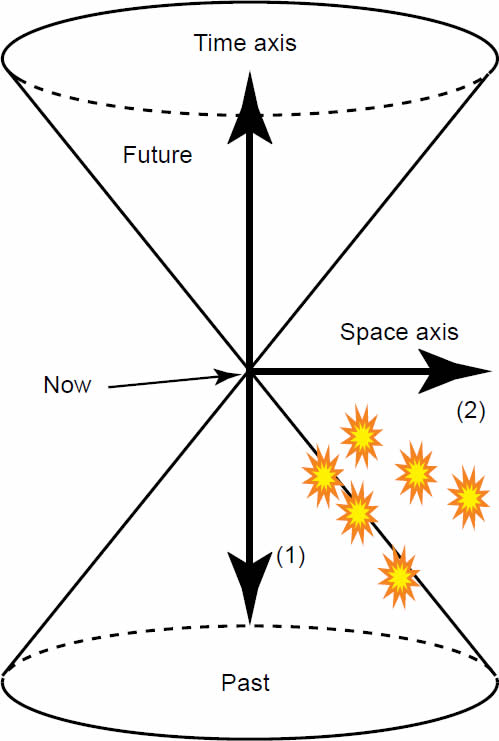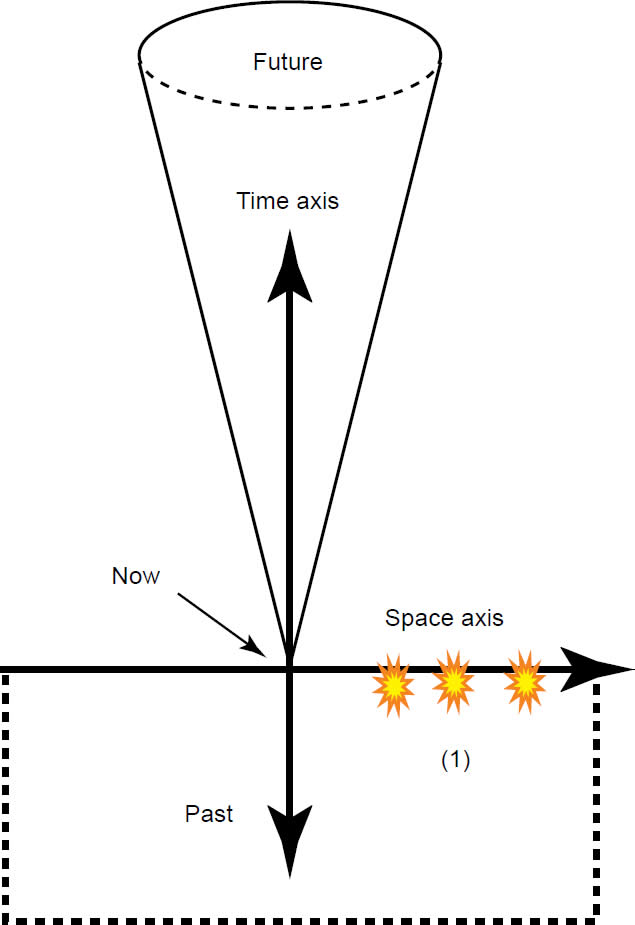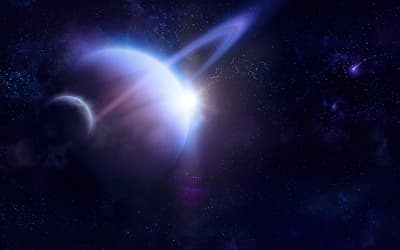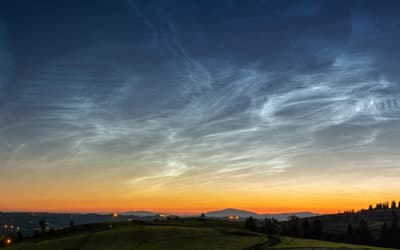The views expressed in this paper are those of the writer(s) and are not necessarily those of the ARJ Editor or Answers in Genesis.
Abstract
According to the Bible the universe is about 6000 years old. It follows from all standard assumptions that we have a starlight-travel-time problem. With the universe being billions of light-years in extent how does light travel across the universe to earth within the timescale of only about 6000 years as laid out by summing up the years represented by the genealogies in Genesis 5 and 11? This problem has been a stumbling block to many simply to believe the inerrant Word of God. Others have attempted to reinterpret the Scriptures to force them to fit in with so-called modern scientific dating of the age of the universe. But is this really necessary? I take another look at the problem and ask the following questions: What is absolutely non-negotiable? What can we say for sure? What defines our universe? And is that consistent from a biblical creationist perspective? The cosmogony I propose involves Lisle’s ASC (Anisotropic Synchrony Convention) model in a static universe with added features and a mechanism for cosmological redshifts, which is consistent with all creationist understandings of the biblical texts, and no light-travel time problem.
Keywords: universe, cosmogony, tired light, ASC model, starlight travel time problem
Introduction
What do we know from science about the size and nature (the physics) of the universe? In the following I list what I believe we know, but there are some necessary, and I think reasonable, assumptions included.
- The universe is extremely large in size—billions of light-years to the most distant observable galaxies. Parallax alone, using space-based telescopes, gives distances to stars out to about 200 parsecs.1 That is a distance of 700 light-years and well within the galaxy. Then there are distance measurement techniques based on Cepheid variable stars, with their absolute brightness determined from their period of pulsation, which have allowed measures outside the galaxy to distances of millions of light-years. Beyond that Tully-Fisher luminosity of galaxies2 have permitted determinations to tens of millions of light-years. But after that astronomers essentially rely on the Hubble law—that is, the redshift of the light from a galaxy is related to its distance.3 And whether or not this redshift implies expansion of the universe, it may well be a reasonable assumption that there is at least a linear relationship between redshift of a galaxy and its distance from earth. The latter is determined from the redshift and luminosity of the galaxies (mostly via type Ia supernova measurements).
- The speed of light (represented by the universal constant c) is constant throughout history. Biblical creationists have extensively discussed the possibility of an historically much faster speed of light but there are no reasonable physical explanations for a much higher speed of light in the past. Furthermore, there are some difficulties for this approach. For example, the energy lost from the shrinking orbits of the Hulse-Taylor binary matches the predictions of general relativity with exquisite accuracy. This system consists of two neutron stars, one being a pulsar. The neutron stars are drawing closer together as they lose energy via the emission of gravitational radiation. If the speed of light (c) in the past was different to that we measure locally today that would be evident. Its current value is always assumed in the Hulse-Taylor binary analysis, and since the binary system is 21,000 light-years from earth it would invalidate the results (Taylor, Fowler, and Weisberg 1979; Weisberg, Taylor, and Fowler 1981). This is because notionally its distance from earth would imply 21,000 years of travel time, assuming constant speed of light, therefore we see into a past when the value of c should have been different according to the idea that it has decayed over time.
- We see the light from distant galaxies billions of light-years away. This is not the same as point 1 though related. My meaning is that it is the light that left those sources, not some sort of fake light created by God to fill the intervening space. The light carries real information with it. Of course, this point carries a very strong assumption. We can’t know if that is actually true, the universe is too large. But God does not lie and we must believe He does not deceive us. (Titus 1:2; Numbers 23:19)
- In the light from distant galaxies we see a systematic redshift of the spectral lines, which has been confirmed at lower redshifts where a measure of galaxy distances was possible by independent means. This is the Hubble law. But it does not necessarily indicate either cosmological expansion of space or Doppler recession of galaxies.(Hartnett 2011d, e). The evidence is equivocal on whether the universe is static or expanding.
- There is evidence in support of, not geocentrism (Hartnett 2014a), but near-galactocentrism. This means that our galaxy cosmologically speaking is somewhere near the centre of the universe (Hartnett 2014b). However the data could be equally well interpreted to mean oscillations in the expansion rate of an expanding universe, if the universe is expanding (Hartnett and Hirano 2008).
What do we know from the Scriptures?
- God said that He created all the stars on Day 4 of Creation Week (Genesis 1:16) which according to the genealogies in Genesis 5 and 11 was about 6000 years ago. Therefore counting with biblical clocks the universe is only about 6000 years old.
- The light from the stars in the heavens must have been visible on Day 4 of Creation Week. In speaking of creating the sun and the moon on Day 4, God says “
he made the stars also
” (Genesis 1:16 KJV) on the fourth day. Therefore, by any definition, all astronomical objects in our solar system and beyond were created on Day 4. - God said He created heaven and earth and all that is in them in six ordinary days (Exodus 20:11). He commanded the children of Israel to order their work week accordingly.
- God spoke to man in a language he could understand. This means the simple truth was understood at the Creation, and at time of Moses, etc, thousands of years ago. At a minimum then the language means the event of creation of the stars must be timed stamped at Day 4. The light from all stars and galaxies therefore must arrive at the earth sometime during Day 4, a 24-hour period as determined by the rotation of the planet. We can surmise that the earth was rotating from Day 1, with a 24-hour period, as measured by earth clocks. God finished all his creating by close of Day 6; this included all the stars (host of heaven, Genesis 2:1).
- God does not necessarily describe an expanding universe in the oft-quoted Scriptures (Hartnett 2011a), therefore it could be static, expanding or collapsing. The Scriptures speak of God creating the host of heaven like putting up a tent (Isaiah 40:22, uses both tent and curtain similes). And the fabric of a tent doesn’t stretch very much. Secondly the Hebrew word מָתַח mathach translated “spreads” in Isaiah 40:22 has the meaning “to spread out or over” as is the case with beaten metal. Another example is רָקַע raqa` translated “spread” has the meaning “hard as a molten looking glass” (a mirror) (Job 37:18). This is hardly like the rubber balloon analogy often used in cosmology.
- The argument can be made that from Scriptures, like Psalm 147:4, the universe is finite in size. The Creator counts the number of stars and He knows them all by name. A finite number is implied, but not proven.
The Starlight-Travel Time Problem
Using the basic equation:
Travel time = Distance ÷ Speed,
applied to a Distance = 1 billion light-years with light travelling at the Speed of light = 1 light-year per year (by definition) then we automatically get a Travel time = 1 billion years for the light from the distant source. So how do you reconcile that with only about 6000 years available from the biblical chronologies?
Various approaches have been taken by creationists, including myself. They include a much faster speed of light in the past (Norman and Setterfield 1987), light created in transit (DeYoung 2010), a miraculous event rather than a physical process (Faulkner 2013), time dilation relativistic models (Hartnett 2007, 2008, 2010, 2013b; Humphreys 2007, 2008), and a timing convention model (Lisle 2010; Newton 2001). Most involve a mature creation in the cosmos to greater or lesser degrees (DeYoung 2010; Faulkner 2013; Hartnett 2007, 2008, 2010, 2013b; Humphreys 2007, 2008; Lisle 2010; Newton 2001; Norman and Setterfield 1987).
In my opinion, all these have some merit with the exception of the light-created-in-transit hypothesis (Norman and Setterfield 1987), which has a fundamental problem with truth in Scripture (if I am understanding it correctly) and the faster-speed-of-light hypothesis (Hartnett 2011a, 2013a), which requires too many “epicycles” to prop up (Hartnett 2014a). But it is encouraging to see that various approaches are being developed to solve the biblical creationist starlight-travel-time problem. Nevertheless I believe it is also important that all approaches are logical and reasonable in the sense that we know God does not lie and all we observe in the cosmos is real history that has occurred (Hartnett 2011b).
Another Look at This Problem
Let’s step back from all previous ideas and ask what absolutely cannot be discarded according to Scripture. We know whatever we suggest, it must conform to Scripture. I do not believe that Scripture can be contorted and wrested to make it fit creation “days” comprising, in reality, of a time period many billions of years long (as measured by earth clocks) as Hugh Ross believes and teaches. He even calls his view a literal interpretation, but it contorts the meaning of the English word “literal.”4 It is literally a non-literal use of the word “literal.”
Defining “The Universe”
Now let’s consider, what is the universe? This is the main point of this article.
According to the usual definition the universe consists of everything that is—the total of all things. How is that defined? Think about that! Before the two-way speed of light (c) (Hartnett 2011c; Lisle 2010)5 was measured to be 299,792.458 km/s,6 humans perceived events to occur simultaneously with the moment they were observed. After the measurement of the two-way speed, c, man’s way of observing and thinking about how events occurred started to change.
Eventually, through a progression of experiments, both gedanken and laboratory tests, it was proposed by Einstein, Minkowski, Poincare, and others that what constitutes the universe is very different to what we might think from our everyday experience (Hartnett 2014c).
This brought about the revolution that broke the dimension of time out of the absolute concept it had, in what we call the Galilean reference frame, and put it on equal footing with the three spatial dimensions in a relativistic reference frame—the Lorentz frame. Time and space were correctly understood by Einstein to be on the same footing. There are no absolute spatial or temporal coordinates. They are interconnected with each other and different observers would come to different conclusions about the sequence of the same observed events depending on their relative motion.
In the easiest to understand terms this meant that one can conceive of events that might have occurred in the past that either are observed or never will be observed on the earth. Relativity introduces what is called a light-cone (see Fig. 1) and all events that occur outside the past light-cone of earth observers are (quite obviously) not observed on earth. This fact results from the finite speed of light. If the speed of light was infinite then, in principle, all past events would be observable. But because the maximum speed information can be communicated from an event (at one location and epoch) to another at another location and epoch is at the speed of the universal constant, the two-way speed of light,7 one can conceive of events that never intersect our worldline.8

Fig. 1. Light-cone drawn in 2D where the Einstein Synchrony Convention (ESC) is assumed. Speed of light is the finite two-way speed c. The slope of the cone is determined by the speed c. The other two spatial dimensions are suppressed.
For example, in an expanding universe two points could separate from each other faster than the speed of light, which would break their causal contact (i.e. they could no longer communicate with each other) and hence an event at one point would not lie in the “universe” of the other as defined by its light-cone. This now involves our definition of the universe. Events or influences that lay or occur outside any causal contact with our causally connected universe cannot be part of this universe.
Alternately, imagine a static universe of finite size, then given sufficient time an event at any point could eventually be seen at any other point in that universe. Though this would necessarily be in the future of that original event. The only way that could be avoided is if the two points were separated by an infinite distance. In a finite space (with what we would call normal topology—space is Euclidean or “flat”) you could say all points (and hence events) are in our universe. Whereas in an infinite space points could be separated such that events occur at one location that can never be seen by another. So we need to learn to speak about events being in or not in the universe. Thus the universe now comprises space and time, not of space alone.
In the normal language of relativity theory, the past light-cone, the spacetime represented by the cone on the bottom in Fig. 1, is in our universe. The light-cone there is drawn under the assumption of the Einstein Synchrony Convention (ESC) (Hartnett 2013a; Lisle 2010; Newton 2001), with the universal limiting speed of light at c. The slope of the edges of the cone indicate this finite speed. The point at the origin, labelled “Now” also is in our universe.9
In Fig. 1, I show two groups of explosions: one is inside our past light-cone (1) and the other outside (2). The explosions inside (1) can be seen “Now” but the other (2) cannot. If the space separating the two points where the explosions (events) occurred is not expanding faster than c, then the explosions outside our past light-cone (2) could intersect with our worldline sometime on our future light-cone. The definition of “the universe” can be made to include only events in our past light-cone.
Under this definition the second group of events (2) is beyond our visible horizon at present. And if those spacetime points are separating faster than the speed of light, then they would always lie beyond that horizon. In such a case I would argue that they are not in our universe. They may well not even exist, yet one could conceive of both our past light-cone and the past light-cone of those events intersecting in the past.10 That means some past event in our universe may have affected the universe of those events, which is a problem the big bang has, called the horizon problem. That problem results from the temperature of the CMB radiation, ostensibly from the big-bang fireball, being too uniform throughout all visible space. That means the temperature measured in all directions in the CMB radiation is nearly identical, but those points have not communicated with each other, so how did they equilibrate? (Lisle 2003)
A different way of defining the universe comes from the proposal of Lisle and the Anisotropic Synchrony Convention (ASC) (Lisle 2010) where the light-cone is shown in Fig. 2. The spacetime of the past light-cone occupies all the region below the space axis. This is because the incoming speed of light, towards the observer, is infinite. All events regardless of their location in space are observed at the earth.

Fig. 2. Light-cone drawn in 2D where the Anisotropic Synchrony Convention (ASC) is assumed. Speed of light is the one-way speed and it is chosen to be infinite towards the observer, which means it must be ½c away from the observer. The slopes of the past and future light-cones are determined by these assumed one-way speeds. The bottom (past) light-cone becomes a cylinder of infinite dimensions and is indicated by the broken lines on three sides.
In this case all past events are in our universe, as they can be observed “Now” at the earth simultaneously with when they occur at the source. The concept of “Now” is still the same as previously, if we define it by when we see an event occur. This is our usual experience.
In this case, the future light-cone has a different slope due to the fact that we must make the outbound speed of light equal to ½c, so that any measurement of the speed of light by reflecting a light signal will always be c, averaged over both inward and outbound distances. This is the measurable two-way speed of light.
Both representations of the universe are valid—with either ESC or ASC. The difference is only a matter of choice of convention—how one wishes to time-stamp events.
Looking at Fig. 2, drawn according to the ASC, you see the explosion events [on the edge of their light-cone, (1)] are always seen as occurring “Now” simultaneously with when they happen. These are the same events (1) as shown in Fig. 1, drawn according to the ESC. That means all stars and galaxies when created on Day 4 would have been seen on earth on Day 4.
Now let’s translate the creation of the stars and galaxies on Day 4 of Creation Week into the language of the ESC light-cone. For all to be seen on Day 4, all must have been created, starting from the most distant, in concentric shells, centred on earth, in a sequence of time (under the ESC) such that the leading edge of the newly created stars was travelling inward at the two-way speed of light, c. This way all galaxies would have been visible (if there was sufficient light and, hypothetically, someone there to observe them) for the first time on Day 4, only about 6000 years ago, as measured by earth clocks, which started ticking at the beginning of creation Day 1.
The total content of this universe then is defined by what we, today, would call the visible universe. It was all visible, in principle, at the first moment of creation on Day 4. Since then about 6000 years of aging has occurred. The difference here, as compared to the big bang universe, is that there can be no unobservable events (locations) outside our lightcone when defined by the ESC. The explosion events (2) defined in Fig. 1 outside our current universe are future events. Matter was not created there and then and hence does not exist yet.
A Biblical Creationist Cosmology and Cosmogony
This naturally leads to a physical cosmological model and cosmogony: All stars and galaxies created with a matter horizon moving towards earth at the speed of light (c) from a finite boundary, and the gravitational field moving inwards at the speed of light as God creates new matter. The light wave front reaches earth on Day 4 as must also the gravitational field of the rest of the universe.
This model leads to measurable effects: inertia of all matter has been conjectured (Mach, Einstein) to arise from the gravitational background field. The redshifts of field galaxies seems to follow a very nice Hubble law dependence, which, I conjecture, arises from this creation condition. It needs further investigation, but this model generates a linear redshift dependence with distance, from the simple fact, that the light from the more distant matter (created earlier when we time-stamp events with the ESC language) has further to travel.
The greater the distance the light travelled to earth the greater the redshift—this is the Hubble law. If that redshift then is due to the accumulation of energy lost by the photons (independent of wavelength) then that would be manifest as a uniform shifting of spectral lines towards the red end of the spectrum. And that is exactly what we do see in the universe. It would be a simple Hubble law, if the effect is linear.
If that is the case, we would expect to see a simple redshift dependence on supernova (SN) light curves. This then brings in substantial discussions about the claimed time-dilation observed in supernova light curves that convolves intrinsic width of the light curve and the time-dilation stretch factor. One cannot be known without the other. In addition, in determining luminosity for the distance moduli, one of the criteria used to reject any candidate SN is its predicted peak absolute magnitude outside of a very narrow range, and that range is determined by its absolute magnitude calculated assuming the standard cosmology (Hartnett 2011d). That is circular reasoning.
There are theoretical grounds for an argument that the speed of light is determined by the substructure of the vacuum (Urban et al. 2013) and hence it is not such a big step to conjecture also that the photons lose energy over cosmological distances, due to their interaction with the quantum vacuum. The effect could be non-dispersive and that is what is observed.
The latter effect could result from energy lost in photons due to the accumulation of matter in the vacuum in the universe during the creation process or simply due to the cosmological distances light travels to earth interacting with the ephemeral particles in the quantum vacuum. That is, it is a distance dependent phenomenon. Hence the decrease of redshift towards the observer.
A Redshift Mechanism
What I propose here is essentially Lisle’s ASC model but with additional refinements and a mechanism for cosmological redshifts, but not resulting from expansion of the universe. The universe in this model can be static, but more likely temporarily static with the potential to collapse, because all we can see in this model is 6000 years of history, as measured by earth clocks. The evidence for expansion is equivocal (Hartnett 2011d, e) and hence this model does not rely on that expansion for a relativistic time dilation effect to solve the light-travel-time problem.
God can sustain His universe as long as He chooses, so we do not need to build in naturalistic initial conditions so that a static, and hence inherently unstable, universe is ruled out. Also we do not need to define it as though it is in some inherently equilibrated conditions, so that sufficient time has elapsed that all regions have had sufficient time to exchange information with each other. The universe we are observing has only existed for 6000 years so that is not a necessary condition.
The model does not reinterpret the length of the days of Genesis 1. They are 24-hour days, and all events in the universe are time-stamped in line with the sequence in Genesis chapter 1. There was no big bang, but a beginning initiated by the Creator of a universe that is essentially just the same as we see it today—a mature creation.
This model defines the universe with concepts consistent with standard concepts of spacetime in Einstein’s relativity theory. The universe is the visible universe, at least, in principle, as there could be galaxies that lie beyond the reach of large telescopes due to the size of the universe. This universe can be finite and bounded, but suggests at a minimum that earth is cosmologically near the centre of the universe and light arrived from all galaxies, for the first time, on Day 4 of Creation Week.
Due to the nature of the quantum vacuum, photons of light, propagating at the speed of light, c, take millions and billions of years to get to earth near the centre of God’s creation, when the ESC is assumed but it arrives instantly, when the ASC is assumed. Photons travelling to earth through the cosmos interact with the quantum foam of virtual particles, which limits their speed to c (a universal constant under the assumption of the ESC, under which all such measurements are made). But the vacuum is not lossless, and over cosmological distances, photons lose energy. Thus the spectral lines of emission and absorption features in the light from distant galaxies are systematically redshifted, proportionally to the distance travelled. The idea I propose is a modification of the “tired light” proposal of Zwicky (1929), but with some differences. The model will be more developed in a sequel to this paper.
This notion is not inconsistent with Edwin Hubble’s own pronouncements when he said in regards to the cause of galactic redshifts,
. . . the possibility that red-shift may be due to some other cause, connected with the long time or distance involved in the passage of the light from the nebula to observer, should not be prematurely neglected. (Hubble and Tolman 1935)
Local Light Limit
It also follows that regions in galaxies that appear to be star-forming regions are in fact just that. We are seeing star-forming events just after God created them, i.e. not forming now but just after they were created. What we observe are fully formed stars, but it is claimed in secular astronomy that these have “evidence of youth” according to the evolutionary idea that stars evolved out of a nebular of gas and dust.
The biblical creationist view would be what we see today is only about 6000 years old, as measured by earth clocks. The one star that is sometimes overlooked is the sun in our solar system. Quite obviously the Creator considers the sun a star (though somewhat more important than the others).
He spoke through David saying,
When I consider thy heavens, the work of thy fingers, the moon and the stars, which thou hast ordained. (Psalm 8:3 KJV) (emphasis added)
Perhaps God did not specifically mention the sun here because it is also a star (Hartnett 2014d). Now God must have created a mature sun, since He created it only four earth rotation days after He created the fledgling planet earth. From Psalm 8:3 we can conclude that the mature creation concept can be applied equally well to all the other stars, as much as it is applied to the sun.
The visible universe gives us the local light limit. At creation this was all the starlight there ever was. There were no events prior that passed earth by more than two light-days. Though a long period of time had passed, under the assumption of the ESC, where starlight progressively filled the universe before man was created, the light from all galaxies including our own was only local for two days prior to Adam’s creation. No hypothetical observer on Days 1 to 3 would have seen anything in the cosmos. Hence, with the ASC as the biblical time-stamping convention, the creation of all stars occurred sometime on Day 4, according to the Genesis record, when the light arrived instantaneously from those sources.
On Day 1,
And God said, “Let there be light”: and there was light. (Genesis 1:3 KJV)
His own light illuminated the earth for Days 1–3 before the light from the sun, moon and stars and the extra-galactic sources arrived at earth. From Day 4 on the events in the cosmos have unfolded very much as we observe today. Galactic processes are very slow and that is generally what we observe. But the Holy Scriptures tell us that a time will come when,
And all the host of heaven shall be dissolved, and the heavens shall be rolled together as a scroll: and all their host shall fall down, . . . . (Isaiah 34:4 KJV) (emphasis added)
And the heaven departed as a scroll when it is rolled together; . . . . (Revelation 6:14 KJV) (emphasis added)
When God’s judgments come the stars (hence galaxies) will be dissolved away (םָקַק maqaq in Isaiah 34:4, meaning to melt but figuratively to dwindle, vanish) or fade away. And both of these verses give the impression, that just like when God created the heavens, like putting up a tent (“spreadeth them out as a tent . . .
” Isaiah 40:22). He will also pull down that tent, when He rolls up the heavens. That rolling up could allude to the reverse process of creating, just as pulling down a tent is the reverse process of putting it up.
So could it be, that at the end of all things, God puts out those lights in the same fashion He created them, in an outward travelling shock wave front, going out from the earth to all the heavens? In this case, it could be much faster than the speed of light, c. Eventually that wave front would reach a radius out in space where the stars and galaxies have died out. They burned out but the earth never saw that part of their lives because that light never reached it (travelling at constant speed c, under the assumption of the ESC).
Conclusion
A basic outline is given for a solution to the biblical creationist starlight-travel-time problem in a static or quasi-static universe with a mature creation. No created-in-transit deception, nor faster speed-of-light nor relativistic time dilation is needed. The days of Genesis creation are 24-hour normal earth rotation days, and even a redshift mechanism is suggested for cosmological redshifts seen in light from distant galaxies. Details of that mechanism are explored in the sequel.
References
DeYoung, D. B. 2010. Mature creation and seeing distant starlight. Journal of Creation 24, no. 3:54–59.
Faulkner, D. R. 2013. A proposal for a new solution to the light travel time problem. Answers Research Journal 6:279–284. http://www.answersingenesis.org/contents/379/arj/v6/light_travel_time_problem.pdf.
Hartnett, J. 2007. A 5D spherically symmetric expanding universe is young. Journal of Creation 21, no. 1:69–74. http://creation.com/images/pdfs/tj/j21_1/j21_1_69-74.pdf.
Hartnett, J. 2008. Starlight, time, and the new physics. In Proceedings of the Sixth International Conference on Creationism, ed. A. A. Snelling, 193–203. Pittsburgh, Pennsylvania: Creation Science Fellowship and Dallas, Texas: Institute for Creation Research.
Hartnett, J. 2010. Starlight time and the new physics. 2nd ed. Atlanta, Georgia: Creation Book Publishers.
Hartnett, J. G. 2011a. Does the Bible really describe expansion of the universe? Journal of Creation 25, no. 2:125–127. http://creation.com/bible-cosmological-expansion.
Hartnett, J. G. 2011b. Modern science in creationist thinking. Journal of Creation 25, no. 3:46–47. http://creation.com/creationism-modern-science.
Hartnett, J. G. 2011c. The Anisotropic Synchrony Convention model as a solution to the creationist starlight-travel time problem. Journal of Creation 25, no. 3:56–62. http://johnhartnett.org/2014/04/05/the-anisotropic-synchronyconvention-model-as-a-solution-to-the-creationiststarlight-travel-time-problem-part-i/. http://johnhartnett.org/2014/04/06/the-anisotropic-synchrony-conventionmodel-as-a-solution-to-the-creationist-starlight-traveltime-problem-part-ii.
Hartnett, J. G. 2011d. Does observational evidence indicate the universe is expanding?—part 1: The case for time dilation. Journal of Creation 25, no. 3:109–114. http://creation.com/expanding-universe-1.
Hartnett, J. G. 2011e. Does observational evidence indicate the universe is expanding?—part 2: The case against expansion. Journal of Creation 25, no. 3:115–120. http://creation.com/expanding-universe-2.
Hartnett, J. G. 2013a. How do we see distant galaxies in a 6000 year old universe? http://johnhartnett.org/2013/12/26/howdo-we-see-distant-galaxies-in-a-6000-year-old-universe/.
Hartnett, J. G. 2013b. A valid finite bounded expanding Carmelian universe without dark matter. International Journal of Theoretical Physics 52, no. 12:4360–4366.
Hartnett, J. G. 2014a. The cosmological principle and geocentrism. http://johnhartnett.org/2014/02/22/thecosmological-principle-and-geocentrism/.
Hartnett, J. G. 2014b. Our galaxy near the centre of concentric spherical shells of galaxies. http://johnhartnett.org/2014/05/26/our-galaxy-near-the-centre-of-concentricspherical-shells-of-galaxies/.
Hartnett, J. G. 2014c. Expansion of space—a dark science. Answers Research Journal 7:453–458. https://answersingenesis.org/astronomy/cosmology/expansionspace-dark-science/.
Hartnett, J. G. 2014d. When I consider thy heavens. http://johnhartnett.org/2014/08/08/when-i-consider-thy-heavens/.
Hartnett, J. G., and K. Hirano. 2008. Galaxy redshift abundance periodicity from Fourier analysis of number counts N(z) using SDSS and 2dF GRS galaxy surveys. Astrophysics and Space Science 318, no. 1–2:13–24. http://arxiv.org/pdf/0711.4885v3.pdf.
Hubble, E. and R. C. Tolman. 1935. Two methods of investigating the nature of nebular red-shift. Astrophysical Journal 82:302–337.
Humphreys, D. R. 2007. Creationist cosmologies explain the anomalous acceleration of Pioneer spacecraft. Journal of Creation 21, no. 2:61–70. http://creation.com/images/journal_of_creation/vol21/5181creationist.pdf.
Humphreys, D. R. 2008. New time dilation helps creation cosmology. Journal of Creation 22, no. 3:84–92. http://creation.com/images/pdfs/tj/j22_3/j22_3_84-92.pdf.
Lisle, J. P. 2003. Light-travel time: a problem for the big bang. Creation 25, no. 4:48–49. http://creation.com/light-traveltime-a-problem-for-the-big-bang.
Lisle, J. P. 2010. Anisotropic Synchrony Convention—A solution to the distant starlight problem. Answers Research Journal 2:191–207. http://www.answersingenesis.org/articles/arj/v3/n1/anisotropic-synchrony-convention.
Newton, R. 2001. Distant starlight and Genesis: Conventions of time measurement. TJ 15, no. 1:80–85. http://creation.com/distant-starlight-and-genesis-conventions-of-timemeasurement.
Norman, T. G. and B. Setterfield. 1987. The atomic constants, light and time. Menlo Park, California: Stanford Research Institute.
Ross, H. 2004. A matter of days: Resolving a creation controversy. Colorado Springs, Colorado: NavPres.
Taylor, J. H., L. A. Fowler, and J. M. Weisberg. 1979. Measurements of general relativistic effects in the binary pulsar PSR1913 + 16. Nature 277:437–440.
Urban, M., F. Couchot, X. Sarazin, and A. Djannati-Atai. 2013. The quantum vacuum as the origin of the speed of light. European Physical Journal D 67, no. 3:58–63. http://arxiv.org/pdf/1302.6165v1.pdf.
Weisberg, J. M., J. H. Taylor, and L. A. Fowler. 1981. Gravitational waves from an orbiting pulsar. Scientific American 245:74–82.
Zwicky, F. 1929. On the red shift of spectral lines through interstellar space. Proceedings of the National Academy of Sciences of the United States of America 15, no. 10:773–779.














